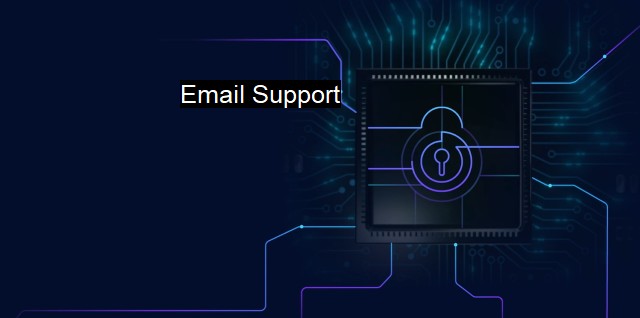What is Email Support?
Best Practices for Email Support: Thwarting Emerging Cybersecurity Risks from Malware, Phishing and Spear-Phishing Attacks
Email support, as fundamental as it might appear, plays a pivotal role in cybersecurity and antivirus mechanisms to ensure businesses and individuals' safety in the digital setting. On a basic level, email support often correlates with providing assistance or help via email structures; in cybersecurity and antivirus contexts the definition of "email support" expands and encompasses a wider scope of complex activities aimed at fortifying confidentiality, strengthening security, and protecting against virtual threats or vulnerability exploits.Within a cybersecurity setting, email support can be illustrated as a set of protective features and mechanisms hinging upon the email framework to combat threatening or malicious activities. Nowadays, emails are persistently targeted by hackers who send phishing messages, distribute malware, or deploy ransomware within seemingly harmless email attachments or embedded hyperlinks. In this context, cybersecurity features provide a robust and multi-layered defence system against these unsolicited attacks. Part of this function rebuts security breaches through automated scanning and isolation of potentially harmful attachments, using sophisticated algorithms to segregate and scrutinize suspicious emails.
Most cybersecurity solutions with email support indulge in behavior analysis and heuristic detection methodologies. The aim is to identify uncommon alterations that signal a looming threat, further bolstering the safeguarding of sensitive or personal data contained within electronic letters. Flagging potentially hazardous emails based on previously identified patterns, and alerting users about the potential threat, is an indispensable criterion laid down by the email support within cybersecurity.
Within an antivirus setting, email support uses established protocols and personalized prescriptions to navigate the menace of digital pathogens. Antivirus software actively screens an attack vector such as emails for known malware signatures, quarantines suspected threats for additional investigation, and eliminates identified viruses to its best extent possible. Included in its role is the decryption of coded messages and dismantling disguised links, revealing the embedded veins of malicious intent. This approach ensures that viral contagions, adept at confidentiality breaches, stand minimized chances of gnawing at the digital entity's immunity.
Email support in antivirus environments extends its influence to real-time examination and verification of email-based activities. It assures encrypted and secure email transactions, protecting both the sender's and recipient's data from undesired interception or unsolicited visibility, maintaining database integrity by inhibiting data leaks and spams. Besides the sender-recipient interactions, safeguards in an antivirus environment with email support spread protection across supplementary functions like address books and stored messages, putting a full-fledged insular boundary around key functions.
Technical email support features vary from basic spam filters to complex two-factor authentication, trafficking protocols, SSL certification, encryption algorithms; human factors remain incalculable and often the weakest link. Therefore, the provision of responsive, round-the-clock assistance for advanced troubleshooting and immediate issue resolution acts as an added and considerable defense layer that intertwines with technology, making email support necessary in cybersecurity and antivirus contexts.
Summarily, in both cybersecurity and antivirus respect, email support fosters a resilient, indefatigable shield for digital communication; ensuring measures against malware proliferation and safeguarding of transactional confidentiality. As digital realm dangers continue to evolve and adapt, the strength of email support systems will define the robustness of our resistance against these ever-advancing threats. Combining an array of intricate features and capabilities, it continues to serve as a strong pillar of support and defense in the digital universe.

Email Support FAQs
What types of cybersecurity issues can email support assist with?
Email support can assist with a range of cybersecurity issues related to email, including but not limited to phishing emails, spam emails, email spoofing, and malware or virus infections through email attachments.How can I reach email support for help with antivirus software issues?
Email support can typically be reached through the support section of your antivirus software's website or through the customer service contact information provided with your software purchase.What steps can I take to protect myself from email-based cybersecurity threats?
To protect yourself from email-based cybersecurity threats, you should regularly update all of your software and antivirus programs, use strong and unique passwords, exercise caution when opening email attachments or clicking on links, and enable two-factor authentication on your email account when possible.What information should I provide to email support when reporting a cybersecurity issue?
When reporting a cybersecurity issue to email support, you should be prepared to provide information such as the date and time of the incident, any error messages or notifications that appeared, the email address or sender from which the threat originated, and any other relevant details of the incident. This will help email support identify and resolve the issue more effectively.| | A | | | B | | | C | | | D | | | E | | | F | | | G | | | H | | | I | | | J | | | K | | | L | | | M | |
| | N | | | O | | | P | | | Q | | | R | | | S | | | T | | | U | | | V | | | W | | | X | | | Y | | | Z | |
| | 1 | | | 2 | | | 3 | | | 4 | | | 7 | | | 8 | | |||||||